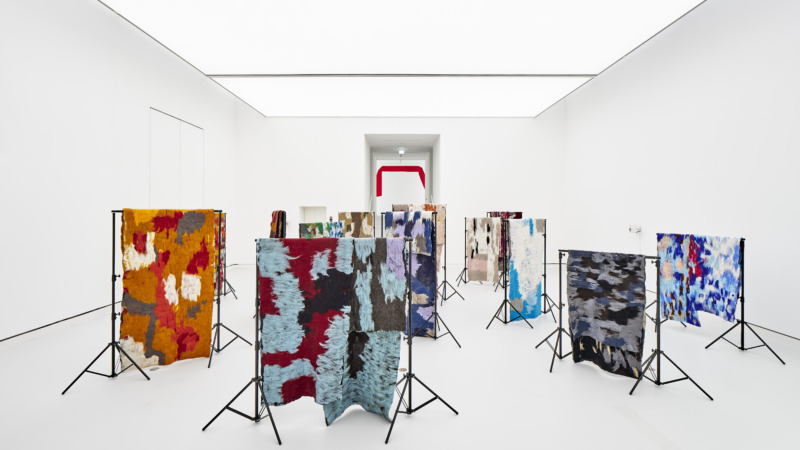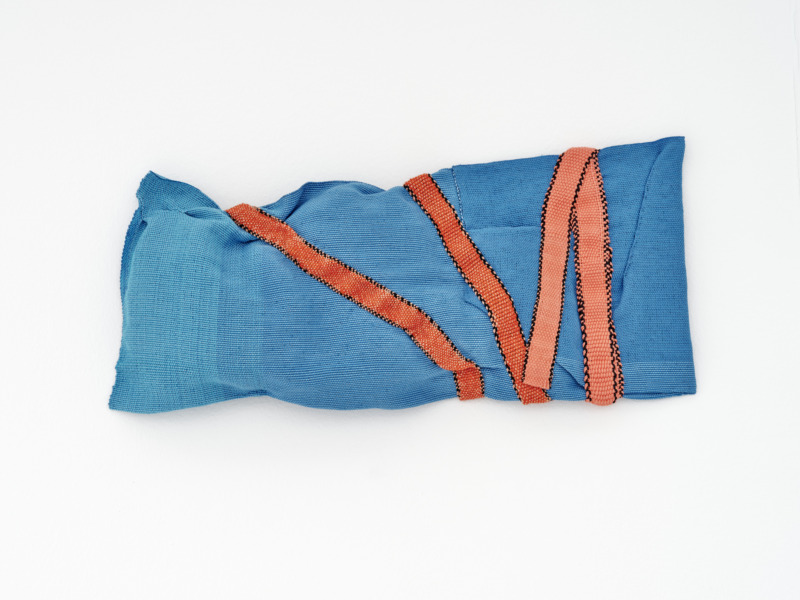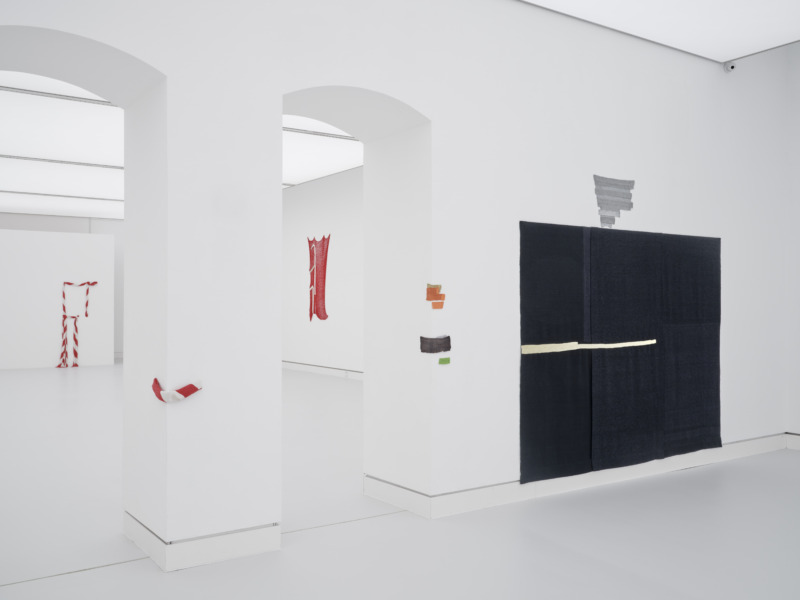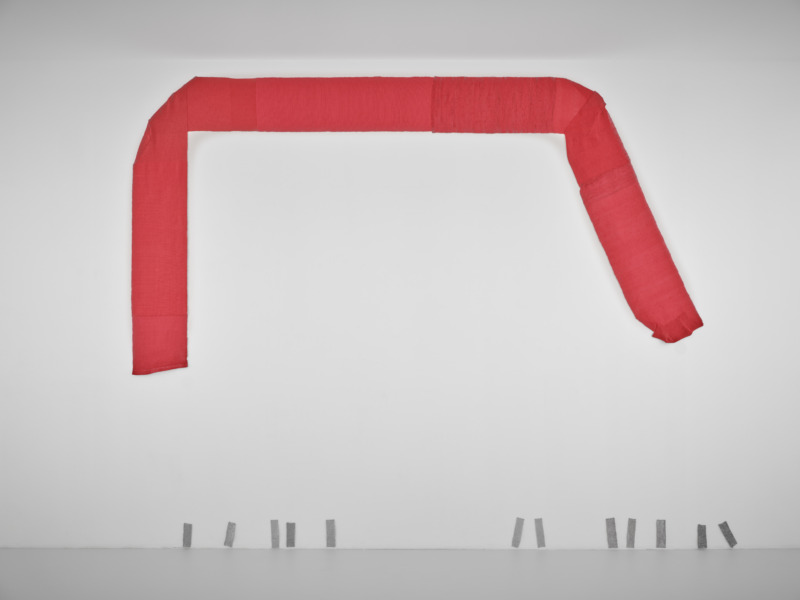
Hana Miletić — Pieces
21/10/22—19/02/23
Dorthe Goeden
Jáchym Fleig
Ivana Matić
Katja von Puttkamer
Judith Röder
21/10/2022–19/02/2023
Hana Miletić’s delicate woven works tell tales about expansion and decay, about injury and healing, about connections across time and space. They form alternative models to the striving for efficiency and the breathlessness that characterize our society.
This is partly on account of the process that her works go through, but also has to do with the technique she has chosen. It all begins with the artist’s making
contact. While strolling through the urban space she not only develops a feeling for it but also searches for indications of situations where there is upheaval, for processes involving transformations. She feels drawn to urban development projects, new housing estates, quarters that have been abandoned or left behind. Hana Miletić captures these initial impressions and places in photographs.
However, she is not content to focus solely on the monumental nature or distinctiveness of urban architecture and street furniture. Instead, she concentrates on details, the unfinished or incomplete. She looks for foil covers that were used temporarily or for protection, or poorly glued attempts to repair sections. Having first taken stock of a place and collected material, she follows this up by defining the topic and selecting the trivialities that are subsequently translated into woven forms. After all, it is precisely such trifles that form the main subjects for Hana Miletić in her perception of the spaces that humans live in and shape, and which then culminate in the actual works of art.
In this way, a tangled mass of plastic foil stuck together in a makeshift manner is transformed into a woven collage of differently nuanced pieces of material of different thicknesses – ranging from paper thin to opaque. Taped sections on street lamps or car windows appear on the wall as an arrangement of colored stripes that can be interpreted in a variety of ways without their original context and sometimes combine to form strange figures. By removing things from their referential setting, translating images into material and temporarily concealing them in the completed object, Hana Miletić abstracts both form and content. Weaving forms the central element of this process of abstraction – a technique that demands both know-how and dexterity but also something that seems strangely out of place today, namely patience.
Opting for such a technique automatically requires a strong passion for material, theme, and the work involved because it is an inefficient method when judged by our current purpose-driven understanding of the world; the results arise gradually and require a certain amount of time, calm, and skill. The artist is driven by a passion but also a deep conviction that these signs of change in urban space, ruptures in communities or personal encounters are worth being perceived and analyzed. She places these pieces of evidence above economic considerations.
She captures them and makes them palpable and not simply as something visual but something to be grasped. It is a quality of Hana Miletić’s artistic practice to transform visual impressions into objects that can be understood. The artist herself describes this approach as “moving from the head to hand and back to the head”.
Let us return to the word „web“ once more which describes a spider’s network of fine gossamer thread used to ensnare its prey. It is also a synonym for a caterpillar’s cocoon. In other words, it refers to something that encloses and preserves. Generally speaking, the term stands for something spun, for a delicate web or net, while in the textile industry it describes an endless thread. These are all meanings that are deeply rooted in Hana Miletić’s work: A captive state and protection, fragility and constancy, routine and its disruption, cooperation and conflict, image and object and naturally endless threads. After all, what we see are not single threads with a beginning and an end but rather webs, nets of threads – visual and physical connections. An extraordinary sensitivity and respect for the state of the present, but also for a shared past, emanates from all these characteristics. Hana Miletić weaves along the fractures of our time, creating constants and connections through the ages.
The presentation Pieces in Kunsthalle Mainz is Hana Miletić’s first solo show in Germany. It will feature existing works and new productions. At its center is the Zollhafen complex – the largest inner-city development project in Mainz.
Pieces is a cooperation with the MMSU – Museum of Modern and Contemporary Art Rijeka.
It will be accompanied by a publication.
From October 2022 to March 2023 FLUX4ART presents the art scene of Rhineland-Palatinate in a state-wide and decentralized way. A total of 60 contemporary artists with a biographical connection to Rhineland-Palatinate will take part in the 3rd edition. The organizer of the Biennale, which took place for the first time in 2018, is the Berufsverband Bildender Künstler*innen Rheinland-Pfalz.
In addition to artworks being presented in Landesmuseum Mainz and in public space, Kunsthalle Mainz is the third venue in the state capital. Presented here are:
Katja von Puttkamer, whose murals extend across the entire stairwell of the tower and culminate in a raster of insights and outlooks. They pick up on the architectural rhythm of the neighbouring residential buildings and thus illuminate the urban constellations and social structures as well as the resulting changes in post-war modernism in Mainz.
Judith Röder‘s installation of overhead projectors and glass panes appears like a meditation on light. It emerges from the interplay of glass and light and creates colourful, dissected pictorial spaces. Through the projection of discarded glass panes, their different material structures are made visible in strict rectangles on the wall, evoking microscopic photographs of skin, tissue, and things grown.
Ivana Matić explores the concept of home. She focuses her gaze on seemingly trivial everyday moments. In her drawings on ceramic, the artist, who lives in Mainz and was born in Serbia, brings together the asynchrony and synchrony of life in both countries. From black-gray strokes and hatchings, she formulates a narrative of fragments.
Dorthe Goeden‘s paper cuts are characterized by their extraordinary fragility and delicacy. Her multi-part works consist of wide and narrow strips that form delicate weaves and take the character of fragile sculptures. The basic element of the work is the line, which, detached from two-dimensionality, questions the boundaries of image, object and space.
Jáchym Fleig‘s sculptural installations are created from accumulations of everyday building materials. He composes sculptural formations that spread like parasitic growths on architecture and exhibition furniture. In the Kunsthalle Mainz, he is growing a large, sand-like floor work as well as a wall relief that spreads like eczema on the wall.
The series is sponsored by the Ministry for Families, Women, Culture and Integration of the State of Rhineland-Palatinate.


Installation view Kunsthalle Mainz: Hana Miletić: Materials 2022

Installation view Kunsthalle Mainz: Hana Miletić: Materials 2018-2022
